KOUFRA, beginning of an epic adventure - 26th January-1st March 1941
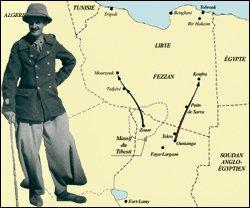
Whilst in Europe the armistice agreements signed by France with Germany and Italy had temporarily brought an end to the fighting across more or less the whole continent, the Italians made the decision to open a new front in Africa. Starting in September 1940, they launched an offensive in Egypt, a country under British control. With their presence in Libya, they presented as much of a threat for the Free French and the French equatorial African countries alongside them, as for the Allies. In fact, in the north of Chad, French equatorial Africa had a long common border with Italian Libya. However, the Free French, in direct contact with the enemy, were able to engage in offensives in the north which would link up with operations led by their British allies from Egypt.
Leclerc, who took command of the troops from Chad on the 2nd December 1940, immediately set about galvanising the forces. Straight away, he launched reconnaissance manoeuvres in Fezzan, Mourzouk and Tedjere. Supported by the New Zealanders and Scots of the Long Range Desert Group (LRDG), Captain Massu's men inflicted heavy material losses on the enemy during a raid on the aerodrome at Mourzouk. The following day, Captain Sarazac's Meharists unsuccessfully attacked Tedjere.
But Leclerc wanted to pull off a major coup by taking the oasis at Koufra. The inaccessibility of the area in effect guaranteed whoever held it complete sovereignty over south eastern Libya. Koufra, an air relay station in the middle of the desert between Italian Libya and Ethiopia, was defended by the El Tag fort and the "Sahariana di Cufra", a Saharan mobile unit comprising a total of about four hundred soldiers. In addition, the Italians, better equipped with better weapons, enjoyed sizeable air cover with at least six aircraft permanently on standby.
In the face of such a machine, Leclerc could not muster up much strength. Once assembled, his column comprised: a company of staff (captains Rennepont and Geoffroy), the nomadic Ennedi unit (Captain Barboteu), an artillery section (Lieutenant Ceccaldi) and two sections of the 7th Company (Captains Florentin and Fabre), a total of some four hundred men - including two hundred and fifty soldiers - mounted on around sixty vehicles. Weaponry was limited to a 75 mm canon, an 81 mm howitzer, four machine guns and twenty six automatic machine guns. The air force was reduced to twelve Blenheim bombers and a few liaison aircraft.
The first encounters were hardly encouraging
The French column left Faya-Largeau, situated 1,000 km north of Fort-Lamy, on the 26th January 1941. Progress was hindered by the wind, thirst, the cold nightly temperatures, the sand and the impassable rocks. Leclerc set up his base in Ounianga before setting off northwards. Conscious of the weakness of his forces, he scheduled three air raids on Koufra, whose mission was to destroy the aerodrome. Only one aircraft on the ground was hit. Meanwhile, Major Clayton's British detachment, which had left as an advance guard, had been torn to pieces by the Italians. The British, very pessimistic about their chances of success, withdrew to Cairo via El Aouina. Although Leclerc could no longer count on the element of surprise, he decided to continue. He left on reconnaissance of Koufra with a small group of sixty men and launched the offensive on his return. He divided his forces into two groups; the first, consisting of two mobile squads and barely a hundred men, took the road to Koufra, followed a day behind on foot by the infantry and artillery.
Leaving from the well at Sarra, the attacking column led by Leclerc came up against the "Sahariana" on the 18th February. The latter, supported by its air force, counter-attacked the next day, but the overwhelmed Italians, believed they were surrounded by great numbers of reinforcements. Cut off from the fort, they withdrew.
They were pursued for 150 km, but were not caught. And so the siege of the fort began. To hide his inferiority of numbers, Leclerc set about creating an illusion. Surrounding himself by mobile patrols, he "created numbers". The single 75 mm canon was regularly moved, whilst the 81 mm howitzer was positioned 1,500 m to the north west of the fort. Night patrols harried the enemy. Acts of support followed, providing no respite. As a result of a mistake, the Italian air force, who had been bombing Leclerc's command post from the start, withdrew. Their pilots thought they could see fighter aircraft in the distance, coming in support of the French troops. After ten days of fighting, the besieged troops, convinced of the superiority of the French forces and deprived of aerial support, agreed to negotiate. On the 1st March, Leclerc opened the door to the fort and, cutting short the negotiations, dictated the conditions of an honourable surrender to the Italian counsel. The French took more than three hundred prisoners: eleven Italian officers and eighteen Italian soldiers and two hundred and seventy three Libyan soldiers. Italian losses amounted to three dead and four wounded. For the Free French Forces, the operation accounted for four dead and twenty one wounded. Seized from the enemy were four 20 mm canons, fifty three machine guns, fourteen vehicles, not to mention a large stock of munitions and supplies.
On the 2nd March, as the French flag was raised for the first time over Koufra, Leclerc promised his men that he would "continue to fight until the French flag flies over Strasbourg again". With these words, Leclerc intended to muster everyone's energy into achieving this goal: reclaiming national territory. It would take about four years of continual effort, but this promise would be kept. In the words of General de Gaulle, bringing back "victory in the folds of the flag" and the taking of Koufra showed that France was still involved in the war beside her allies. Leclerc was thus able to start preparations for his next objective: conquering Fezzan.
Key dates
The Koufra area
Koufra is a group of oases, situated in Libya, an isolated spot in the middle of the desert more than 400 kilometres from any inhabited area. This area of the Sahara has many features, from the large mountainous range (Tibesti) to the plateaux covered with stones and dunes. This desert is a land of rocks, sand and a wind that shapes and moves the dunes, regularly redesigning the landscape. In this desolate expanse, the distances involved are considerable - some 2 000 km separate Fort-Lamy from Koufra -compounded further by the detours demanded by the nature of the terrain. Water is rare here with just a few wells and oases dotted here and there. The Italians, present in Libya since 1912, brought peace to the country in 1931. The taking of Koufra, as a result of campaigns led by Marshal Graziani against the Senoussis, was therefore hailed as a great victory by Mussolini. He turned Koufra into a heavily armed and defended fortress. The fort at El Tag, a square structure 150 metres long on each side with 4 m high walls, was built on a rocky outcrop at Djebel el Bub. Standing alone, it was surrounded by an extensive external underground defence system with the capacity for long-range fire. Defended by a garrison of some three hundred men, it also had a mobile company, the "Compania sahariana di Cufra" and a squadron of reconnaissance aircraft, light Ghibli bombers and Savoia bombers. The "Sahariani"
The Italians set up large garrisons across the whole of Libya, particularly in the south. To complement the defence of these strongholds, they set up Saharan mobile units: the "Sahariani". These units formed the mobile element for defence and protection. They were therefore especially well equipped for the war of movement in the desert. A "Sahariana" comprised of seventy six to one hundred and forty seven men, with fifteen to twenty military vehicles, including Spa tractors, with enormous wheels, perfectly adapted to the terrain. Its weaponry basically consisted of four 20 mm canons, four heavy 12.7 mm machine guns and eleven light 7.7 mm machine guns. It also had the advantage of large reserves: five days' worth of water, a month's supplies and six hundred kilometres of autonomy. It was thus capable of travelling a long way into enemy territory and could be employed at any moment to defend a position. The "Sahariani" intervened in association with an air force, composed initially of three and later six aircraft, carrying out missions of reconnaissance, combat, supply and medical evacuation. Italy had five units in 1940, based in Ubari, Mirda, Serdeles, Koufra and Mourzouk. Leclerc, known as Philippe de Hauteclocque (Belloy-Saint-Léonard 22nd November 1902 - near Colomb-Béchar 28th November 1947):
A cavalry officer graduating from Saint-Cyr, promoted to the "Metz and Strasbourg" division, Philippe de Hauteclocque first served in Morocco before taking up a position as an instructor at Saint-Cyr. He established the École de guerre in 1938, before being mobilised and taking an active part in the French campaign. Wounded and taken prisoner by the Germans, he escaped to England where he rallied the Free French. Captain de Hauteclocque then took the name Leclerc. Successful in Africa, he brought back the support of Cameroon for the Free French cause in August 1940 and then was involved in securing the support of Gabon in November. Appointed commander of the troops of Chad, he planned a series of raids on the Italian positions at Fezzan and seized Koufra on the 1st March 1941. For this victory, General de Gaulle made him Compagnon de la Libération on the 6th March the same year. He launched a general offensive in Libya in December 1942 and linked up with the 8th British army in Tripoli in January 1943. Following the Tunisian campaign, he was put in charge of the 2nd armoured division, with whom he landed in Normandy on the 1st August 1944. After the Liberation of Paris, he took part in battles in the Vosges and Alsace and then in the final fighting that ended in Berchtesgaden in Germany. Appointed commander of the French expeditionary corps to the Far East, he signed the Japanese surrender agreement alongside the Allies. Whilst acting as inspector of the North African forces, General Leclerc died in an aircraft accident near Colomb-Béchar. He was posthumously made Marshal of France in 1952. Résumé : Leclerc, then the commandant of troops from Chad, wanted to pull off a great coup by taking the oasis at Koufra, whose inaccessibility guaranteed whoever held it complete sovereignty over south eastern Libya: it was the beginning of an epic adventure that would end in Strasbourg and Berchtesgaden.
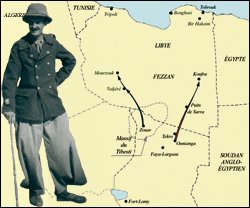
Click on the map to enlarge

The fort at Mourzouk. Source: Memorial to Leclerc and the Liberation of Paris / Jean Moulin Museum (Mairie de Paris)
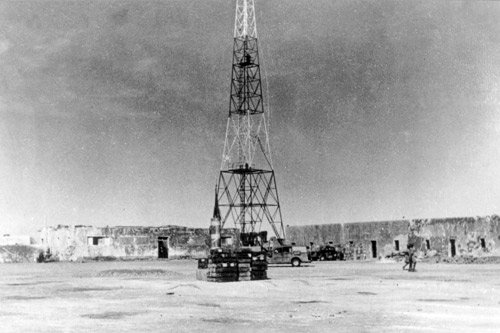
View of the inside of the El Tag fort.
Source: Memorial to Leclerc and the Liberation of Paris / Jean Moulin Museum (Mairie de Paris)
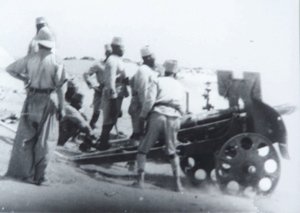
The French 75 Montagne Schneider canon .
Source: Memorial to Leclerc and the Liberation of Paris / Jean Moulin Museum (Mairie de Paris)
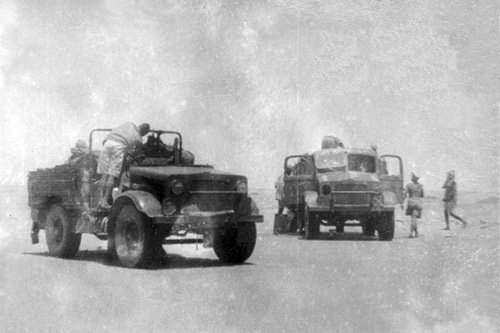
Bedford lorries between Koufra and Faya-Largeau.
Source: Memorial to Leclerc and the Liberation of Paris / Jean Moulin Museum (Mairie de Paris)
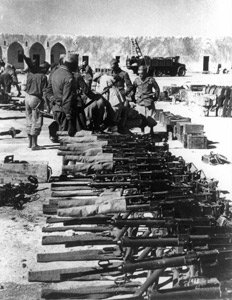
The haul taken from the Italians.
Source: Memorial to Leclerc and the Liberation of Paris / Jean Moulin Museum (Mairie de Paris)
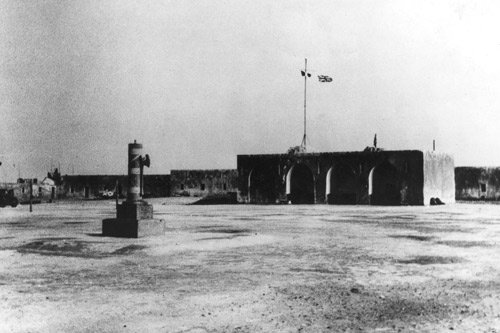
French and British colours fly over the El Tag fort.
Source: Memorial to Leclerc and the Liberation of Paris / Jean Moulin Museum (Mairie de Paris)
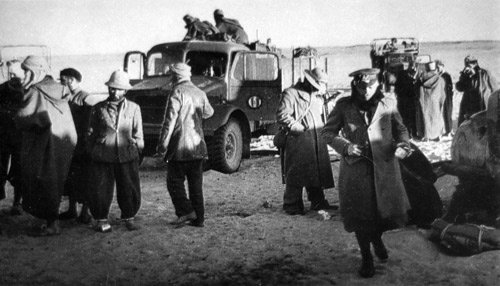
Italian prisoners on the road between Koufra and Faya-Largeau.
Source: Memorial to Leclerc and the Liberation of Paris / Jean Moulin Museum (Mairie de Paris)
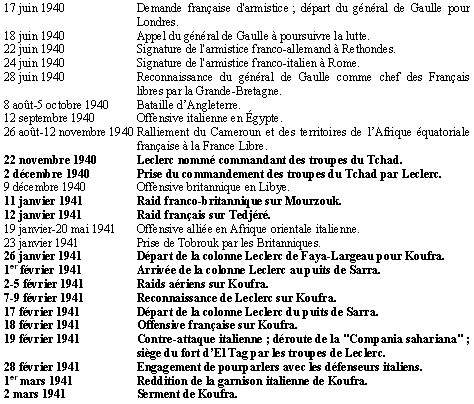
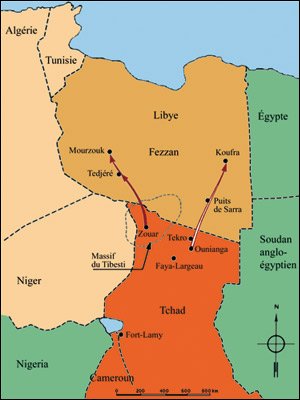
Towards Koufra, January-March 1941
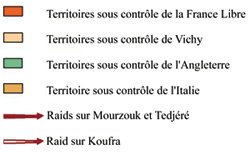
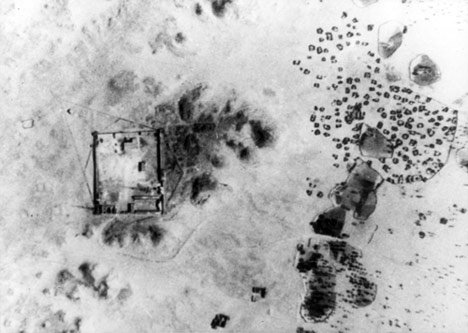
Aerial view of the fort at Koufra.
Source: Memorial to Leclerc and the Liberation of Paris / Jean Moulin Museum (Mairie de Paris)
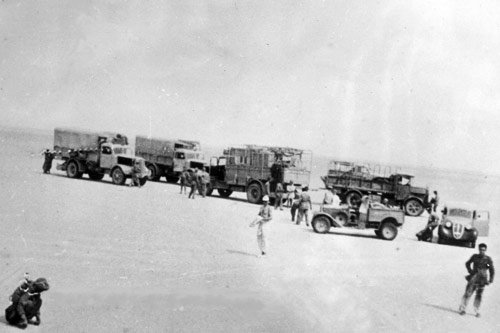
Italian mobile column ("Sahariana").
Source: Memorial to Leclerc and the Liberation of Paris / Jean Moulin Museum (Mairie de Paris)
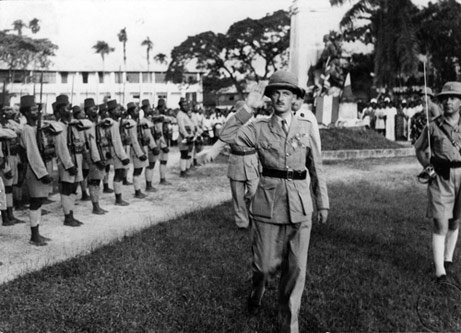
Fort-Lamy, December 1940, Leclerc takes over command of Chad troops.
Source: ECPAD France

